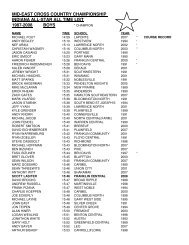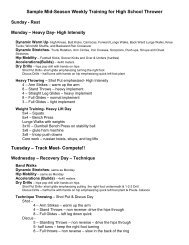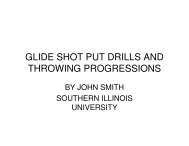Judge-Plyometric Training for Track and Field-200.pdf - iatccc
Judge-Plyometric Training for Track and Field-200.pdf - iatccc
Judge-Plyometric Training for Track and Field-200.pdf - iatccc
You also want an ePaper? Increase the reach of your titles
YUMPU automatically turns print PDFs into web optimized ePapers that Google loves.
Conditioning <strong>for</strong> <strong>Plyometric</strong>s<br />
Higher than normal <strong>for</strong>ces are put on the musculoskeletal system during plyometric exercises so it is<br />
important <strong>for</strong> the athlete to have a good sound base of general strength <strong>and</strong> endurance. Most experts<br />
state that a thorough grounding in weight-training is essential be<strong>for</strong>e you start plyometrics.<br />
It has been suggested that an athlete be able to squat twice his body weight be<strong>for</strong>e attempting depth<br />
jumps. However, less intensive plyometric exercises can be incorporated into general circuit <strong>and</strong><br />
weight training during the early stages of training so as to progressively condition the athlete.<br />
Simple plyometric drills such as skipping hopping <strong>and</strong> bounding should be introduced first. More<br />
dem<strong>and</strong>ing exercises such as flying start single-leg hops <strong>and</strong> depth jumps should be limited to<br />
thoroughly conditioned athletes.<br />
Planning a <strong>Plyometric</strong> Session<br />
The choice of exercises within a session <strong>and</strong> their order should be planned. A session could :<br />
Begin with exercises that are fast, explosive <strong>and</strong> designed <strong>for</strong> developing elastic strength (low hurdle<br />
jumps; low drop jumps)<br />
Work through exercises that develop concentric strength (st<strong>and</strong>ing long jump; high hurdle jumps)<br />
Finish with training <strong>for</strong> eccentric strength (higher drop jumps).<br />
Planning a <strong>Plyometric</strong> Session<br />
An alternative session could be:<br />
Begin with low hurdle jumps<br />
Progress to bounding <strong>and</strong> hopping,<br />
Continue with steps or box work<br />
Finish with medicine ball work out <strong>for</strong> abdominals <strong>and</strong> upper body.<br />
Warm up<br />
A thorough warm up is essential prior to plyometric training. Attention should be given to jogging,<br />
stretching (static <strong>and</strong> ballistic), striding <strong>and</strong> general mobility especially about the joints involved in the<br />
planned plyometric session. A cool down should follow each session.<br />
Multiple Jump Exercises (Preparation Phase)<br />
Beginners<br />
Power Skip <strong>for</strong> Height<br />
Prepartion Phase <strong>Plyometric</strong>s Ground Level)<br />
Bounding, skip <strong>for</strong> height, skip <strong>for</strong> distance, frog jumps<br />
St<strong>and</strong>ing broad jumps, vertical jumps, rocket jumps<br />
Preparation Phase Multiple Jump Exercises<br />
Tuck Jumps<br />
How to per<strong>for</strong>m the drill<br />
Begin in a st<strong>and</strong>ing position<br />
Jump up, grabbing both knees as they come up your chest<br />
Return to the starting position l<strong>and</strong>ing on the balls of the feet<br />
Try to anticipate the l<strong>and</strong>ing <strong>and</strong> spring up as quickly as you can<br />
Keep the feet touch down time on the ground to the shortest time possible<br />
How much<br />
1 to 3 sets
















